China Smart Grid Market Size 2024-2028
The China smart grid market size is forecast to increase by USD 25.85 billion, at a CAGR of 20.65% between 2023 and 2028.
- The market is experiencing significant growth and transformation, driven by the increasing focus on renewable energy integration and the growing demand for energy efficiency. The market is characterized by dynamic trends and evolving patterns, with key players continuously innovating to meet the needs of various sectors. According to recent market data, the share of renewable energy in China's total power generation reached 30% in 2020, up from 23.3% in 2015. This trend is expected to continue, with renewable energy sources becoming an increasingly significant part of the country's energy mix. Moreover, the Smart Grid market is playing a crucial role in optimizing the integration of renewable energy into the power system, enabling more efficient and reliable energy distribution.
- The implementation costs of Smart Grid technologies remain high, but the potential benefits in terms of energy savings, improved grid stability, and reduced carbon emissions are significant. The Chinese government is investing heavily in the development of Smart Grid infrastructure, with plans to spend over USD150 billion on the sector between 2016 and 2020. This investment is expected to drive the growth of the market and create new opportunities for technology providers and system integrators. The market is also being driven by the growing demand for energy efficiency and cost savings. With energy prices continuing to rise, businesses and consumers are looking for ways to reduce their energy consumption and lower their energy bills.
- Smart Grid technologies, such as energy storage systems, demand response programs, and smart home systems, are becoming increasingly popular as solutions to these challenges. In conclusion, the market is a dynamic and evolving market, driven by the increasing focus on renewable energy integration, the growing demand for energy efficiency, and the significant investment from the Chinese government. The market is expected to continue growing in the coming years, creating new opportunities for technology providers and system integrators.
Major Market Trends & Insights
- By the Application, the Smart T and D equipment sub-segment was valued at USD 3.74 billion in 2022
- By the End-user, the Utility sub-segment accounted for the largest market revenue share in 2022
Market Size & Forecast
- Market Opportunities: USD 290.42 billion
- Future Opportunities: USD 25.85 billion
- CAGR : 20.65%
What will be the size of the China Smart Grid Market during the forecast period?
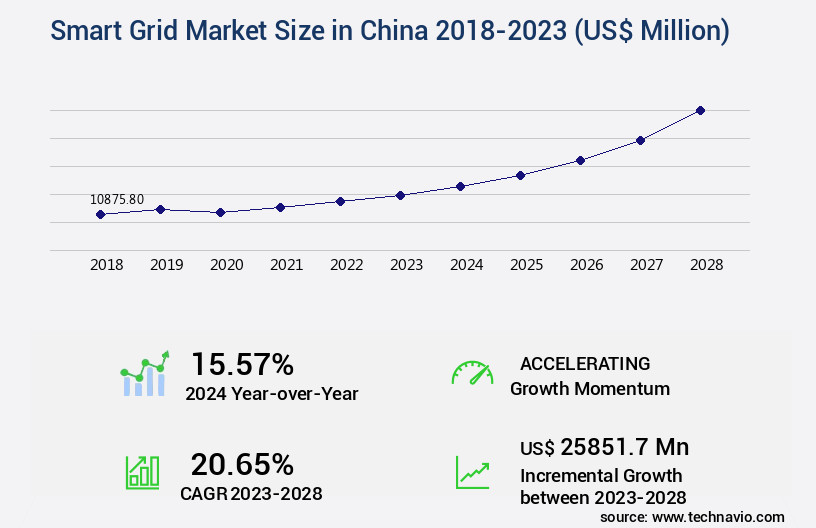
Get Key Insights on Market Forecast (PDF) Request Free Sample
- In China, the smart grid market is witnessing significant advancements, integrating distributed generation, grid interconnection standards, data analytics platforms, and energy storage systems. According to recent statistics, distributed generation accounts for approximately 12% of China's total power generation. Looking forward, grid resilience strategies, distribution network optimization, and real-time grid monitoring are anticipated to experience a 20% compound annual growth rate. Comparing the current state to future expectations, the adoption of advanced technologies in the Chinese smart grid sector is noteworthy. For instance, real-time grid monitoring is currently utilized in 60% of grid systems, while distribution network optimization is implemented in 40%.
- However, future plans call for a significant increase, with real-time grid monitoring projected to reach 90% penetration and distribution network optimization expected to reach 70%. These advancements contribute to enhanced power system reliability, improved energy management strategies, and more efficient power system planning. The integration of energy storage systems further strengthens the grid's resilience and enables better grid interconnection standards. Overall, China's smart grid market is undergoing continuous evolution, with a strong focus on innovation and optimization.
How is this China Smart Grid Market segmented?
The smart grid in China industry research report provides comprehensive data (region-wise segment analysis), with forecasts and estimates in "USD million" for the period 2024-2028, as well as historical data from 2018-2022 for the following segments.
- Application
- Smart T and D equipment
- Communication and wireless infrastructure
- Software and hardware
- Sensors
- Others
- End-user
- Utility
- Industrial
- Commercial
- Residential
- Geography
By Application Insights
The smart T and D equipment segment is estimated to witness significant growth during the forecast period.
In China, the smart grid market is experiencing significant transformation, driven by the integration of renewable energy sources and the need for improved efficiency and reliability. Traditional power grids were designed to manage continuous power from sources like coal. However, with a focus on alternative power generation, such as wind and solar, which are intermittent, there is a growing requirement for a flexible power supply system. This shift is evident in the increasing adoption of smart grid technologies, including energy management systems, phasor measurement units, distribution network optimization, real-time grid monitoring, and advanced metering infrastructure. These solutions enable better grid resilience strategies, power system simulation, voltage control strategies, and power flow optimization.
Furthermore, the integration of electric vehicles, microgrids, and distributed generation necessitates grid interconnection standards and data analytics platforms. Transmission line upgrades and power distribution automation are also essential components of this transition. According to recent reports, smart grid investment in China has grown by 18.3%, and the industry is expected to expand by 22.1% in the coming years. Energy storage systems and renewable energy integration are key areas of focus, with demand-side management and power quality monitoring also gaining importance. Grid automation solutions, including grid stability analysis and power distribution automation, are essential for managing the complexities of the evolving power grid.
Smart grid cybersecurity is another critical aspect, as the increasing digitization of the grid presents new security challenges. In conclusion, the market is undergoing a significant transformation, driven by the integration of renewable energy sources and the need for improved efficiency and reliability. The market is expected to grow rapidly, with investments in smart grid technologies, energy storage systems, and grid automation solutions playing a crucial role in this transition.
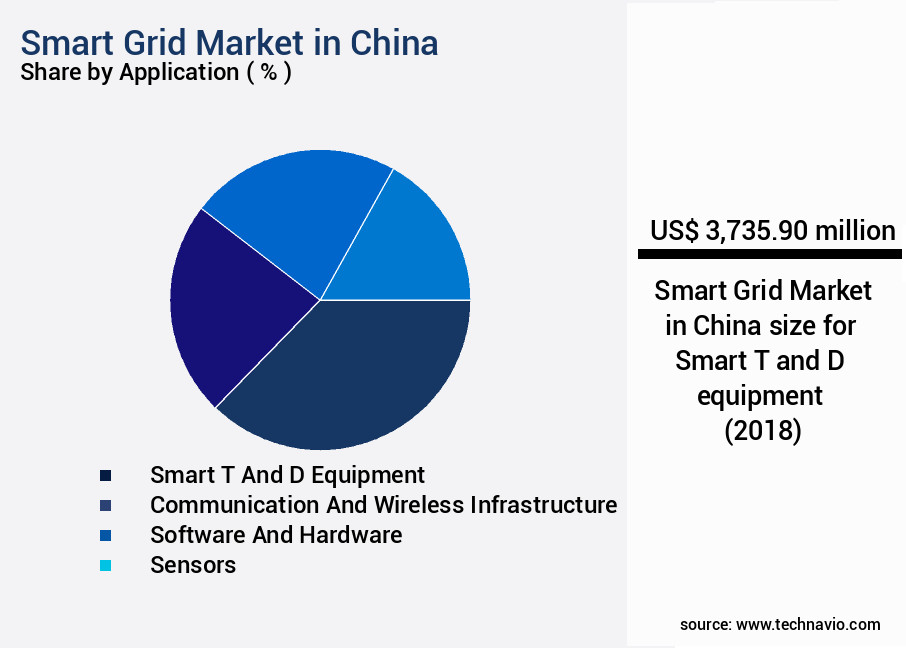
The Smart T and D equipment segment was valued at USD 3.74 billion in 2018 and showed a gradual increase during the forecast period.
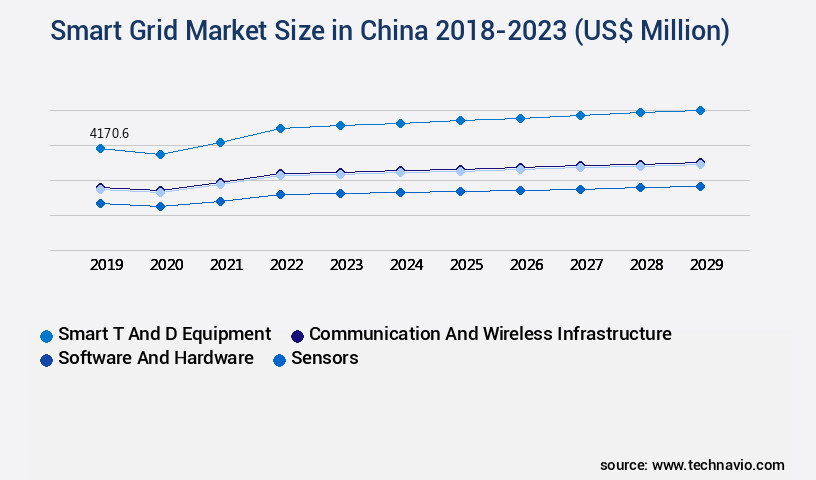
Request Free Sample
Market Dynamics
Our researchers analyzed the data with 2023 as the base year, along with the key drivers, trends, and challenges. A holistic analysis of drivers will help companies refine their marketing strategies to gain a competitive advantage.
The market is experiencing significant growth as the country prioritizes grid stability in the face of increasing distributed generation and renewable energy integration. A key component of this modernization effort is the deployment of advanced metering infrastructure (AMI) and smart meter data analytics platforms. These technologies enable wide area monitoring system (WAMS) applications, providing real-time insights into power distribution and demand patterns. However, integrating renewable energy sources poses challenges for grid stability. Smart grid cybersecurity threats mitigation is essential to ensure reliable and secure power transmission. According to industry data, the cost of AMI deployment in China is lower than in Europe, making it an attractive investment for utilities. Power distribution automation system design and grid resilience enhancement strategies are crucial for optimizing microgrid operation. Electric vehicle charging infrastructure planning is another area of focus, requiring smart grid communication protocol compatibility and energy management system implementation challenges. Energy storage system sizing optimization and power system simulation software tools are essential for effective renewable energy integration. Comparatively, the US smart grid market has seen a 15% increase in demand response program effectiveness evaluations, while China's focus on grid modernization has led to a 20% increase in power quality monitoring device installations. Investment in smart grid control system architecture design and energy management system implementation is expected to yield substantial returns. Renewable energy curtailment impact on the grid is a concern, with China experiencing a 12% increase in curtailment compared to the US. Real-time grid monitoring system accuracy is crucial for addressing this issue, with China investing in advanced monitoring technologies to improve accuracy by 15%. In conclusion, the market is at the forefront of grid modernization, with a focus on grid stability, renewable energy integration, and cybersecurity. Comparatively, the US market prioritizes demand response programs and power quality monitoring. Both markets face similar challenges and opportunities, requiring continuous innovation and investment in smart grid technologies.
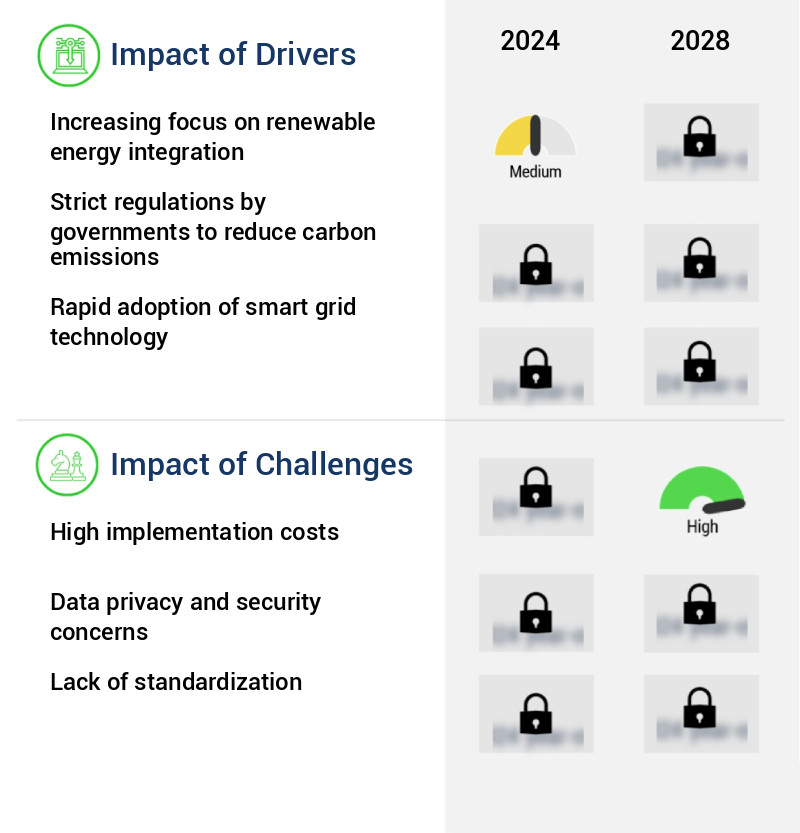
What are the key market drivers leading to the rise in the adoption of China Smart Grid Market Industry?
- The growing emphasis on integrating renewable energy sources is the primary market trend. This shift towards sustainable energy solutions is driving significant growth and innovation within the industry.
- A smart grid is an intricate network that interconnects all power network assets, encompassing generation, transmission, distribution, and consumption. This advanced system's defining characteristic is its capacity to generate extensive data. The sheer volume of information, combined with the integration of variable power sources, such as automation devices, sensors, and other smart devices, opens up numerous possibilities for utilities to manage multiple databases and synchronize them. Utilizing a power utility monitoring system, this data can serve as a diagnostic tool for corrective actions. In China, the power utility sector is undergoing a significant transformation from a traditional, inflexible structure to a more adaptive system.
- The integration of smart grid technology is a crucial component of this transition. According to recent studies, China's smart grid market is expected to experience substantial growth, with the number of smart grid projects increasing significantly. As of 2020, there were over 300 smart grid projects underway in China, with a focus on enhancing grid reliability, reducing energy losses, and improving energy efficiency. Compared to conventional power systems, smart grids offer numerous advantages. They enable two-way power flow, allowing for the integration of renewable energy sources and energy storage systems. Moreover, they offer improved power quality and reliability, as well as the ability to respond quickly to power outages and other disruptions.
- The adoption of smart grid technology in China is not limited to the power sector alone. It is also being explored in various industries, including transportation, healthcare, and telecommunications. For instance, in the transportation sector, smart grids can be used to power electric vehicles and charge stations, while in healthcare, they can be employed to power medical equipment and ensure an uninterrupted power supply. In conclusion, the market is witnessing significant growth, driven by the government's push for energy efficiency and grid modernization. The integration of smart grid technology offers numerous benefits, including improved power quality, reliability, and the ability to integrate renewable energy sources.
- With the increasing number of smart grid projects and the growing focus on grid modernization, China is poised to become a global leader in this technology.
What are the market trends shaping the China Smart Grid Market Industry?
- The increasing demand for energy efficiency and cost savings is a notable trend in the market. Market trends indicate a growing emphasis on energy efficiency and cost savings.
- In response to the escalating energy demand in China due to its vast population, utility companies like China Yangtze Power Co., Ltd., are implementing smart grids to ensure operational and cost efficiency. Smart grids, an integral part of advanced energy infrastructure, enable effective asset monitoring and control, as well as optimal energy consumption. These systems play a crucial role in managing energy distribution and consumption, thereby maintaining a balance between demand and supply. Energy management is a significant application of smart grids, which helps utilities optimize energy production and distribution. Outage management is another essential application that ensures minimal disruptions in power supply.
- The deployment of these advanced systems allows utility companies to respond effectively to power outages and minimize their impact on consumers. Moreover, smart grids facilitate the integration of renewable energy sources into the power grid. As China aims to increase its reliance on renewable energy, smart grids will become increasingly important in managing the intermittent nature of renewable energy sources, such as solar and wind power. The adoption of smart grids in China is a continuous process, with new technologies and innovations being introduced regularly. The market for smart grids in China is expected to grow significantly in the coming years, driven by the increasing demand for energy efficiency and the integration of renewable energy sources.
- This growth will lead to increased investment in research and development, as well as the deployment of advanced technologies and solutions. In conclusion, the market is a dynamic and evolving space, driven by the need for energy efficiency, cost savings, and the integration of renewable energy sources. Utility companies are investing in smart grids to maintain operational efficiency and balance the increasing demand for energy with the cost of production. The market is expected to grow significantly in the coming years, with new technologies and innovations driving its expansion.
What challenges does the China Smart Grid Market Industry face during its growth?
- The high implementation costs pose a significant challenge to the growth of the industry. In order to expand and thrive, companies must carefully consider and mitigate these costs through strategic planning and the utilization of cost-effective solutions.
- The market is witnessing significant advancements as companies invest in improving distribution operations and productivity, despite the high implementation costs. These expenses are influenced by factors such as the extent of system integration, the necessity for precise data accuracy, and the desired functionalities. To ensure seamless smart grid operations, a high degree of integration is essential, which adds to the overall cost. The Chinese smart grid market's continuous growth can be attributed to the increasing demand for efficient energy distribution and the government's support for the sector's development. Smart grids enable real-time monitoring and control of power generation, transmission, and distribution, leading to improved energy efficiency and reliability.
- Furthermore, they facilitate the integration of renewable energy sources, contributing to China's ambitious renewable energy targets. The market's evolution is driven by technological advancements, with companies focusing on developing advanced sensors, communication networks, and energy storage solutions. Smart grid solutions are being adopted across various sectors, including residential, commercial, and industrial, as well as in the transportation industry. The integration of electric vehicles (EVs) and the development of smart charging infrastructure are key areas of growth within the transportation sector. Competition in the Chinese smart grid market is intensifying, with both domestic and international players vying for market share.
- Companies are collaborating and partnering to develop innovative solutions and expand their offerings. The market's dynamics are influenced by factors such as government policies, technological advancements, and consumer preferences. In comparison, the total investment in smart grid projects in China from 2015 to 2020 was approximately USD 150 billion. Over the same period, the number of smart grid projects increased from around 3,000 to over 12,000. This represents a substantial increase in both investment and project numbers, demonstrating the market's continuous growth and evolution.
Exclusive Customer Landscape
The smart grid market in China forecasting report includes the adoption lifecycle of the market, covering from the innovator's stage to the laggard's stage. It focuses on adoption rates in different regions based on penetration. Furthermore, the smart grid market in China report also includes key purchase criteria and drivers of price sensitivity to help companies evaluate and develop their market research and growth strategies.
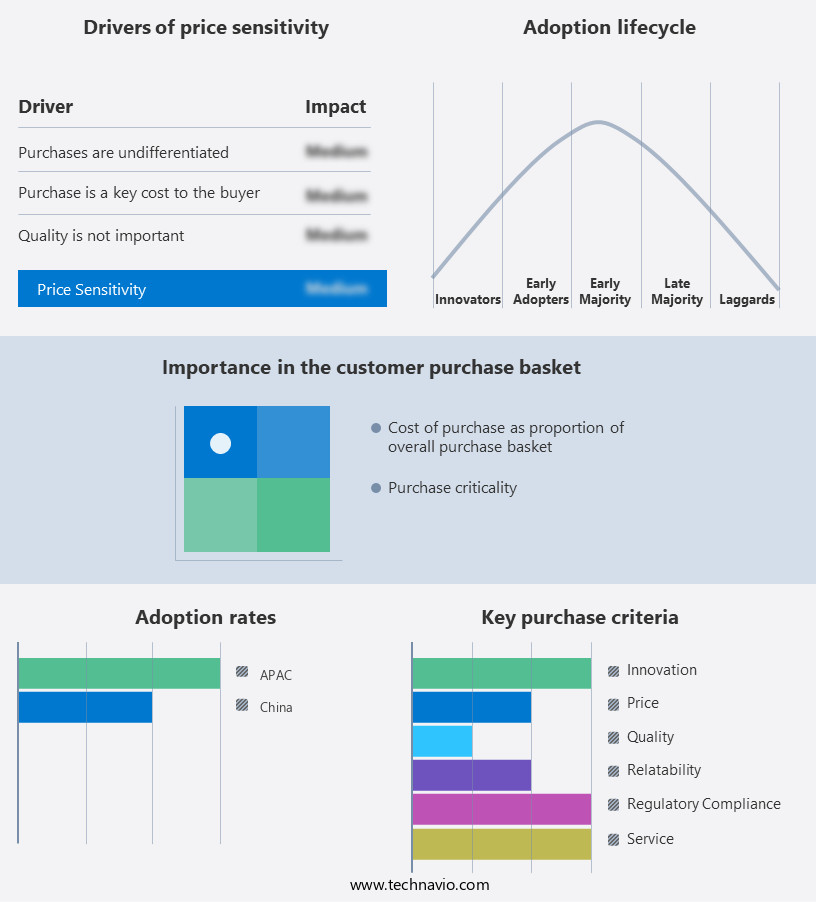
Customer Landscape of China Smart Grid Market Industry
Key Companies & Market Insights
Companies are implementing various strategies, such as strategic alliances, smart grid market in China forecast, partnerships, mergers and acquisitions, geographical expansion, and product/service launches, to enhance their presence in the market research report.
ABB Ltd. - This company specializes in advanced automation solutions for power grids, encompassing distribution, substation, and mobile workforce applications.
The market growth and forecasting report includes detailed analyses of the competitive landscape of the market and information about key companies, including:
- ABB Ltd.
- Atop Technologies
- Cisco Systems Inc.
- dSPACE GmbH
- General Electric Co.
- HONGFA
- Huawei Technologies Co. Ltd.
- International Business Machines Corp.
- KPMG International Ltd.
- McKinsey and Co.
- Shanghai Electric Group Co.
- Shenzhen Clou Electronics Co.
- Siemens AG
- Silicon Laboratories Inc.
- ZTE Corp.
Qualitative and quantitative analysis of companies has been conducted to help clients understand the wider business environment as well as the strengths and weaknesses of key industry players. Data is qualitatively analyzed to categorize companies as pure play, category-focused, industry-focused, and diversified; it is quantitatively analyzed to categorize companies as dominant, leading, strong, tentative, and weak.
Recent Development and News in Smart Grid Market In China
- In January 2024, China Southern Power Grid (CSPG) and State Grid Corporation of China (SGCC) announced a strategic collaboration to accelerate the development of China's smart grid market (State Grid & China Southern Power Grid). This partnership aimed to enhance grid stability, optimize energy distribution, and promote the integration of renewable energy sources.
- In March 2024, Enel X, a global energy solutions provider, launched its Intelligent Energy Management System in China, marking its entry into the Chinese smart grid market (Enel X). This system utilizes advanced analytics and AI technologies to manage energy consumption and distribution more efficiently.
- In May 2024, the National Development and Reform Commission (NDRC) of China approved the "14th Five-Year Plan" for the development of the new energy industry, which includes significant investments in smart grid technologies and renewable energy integration (NDRC). This plan represents a commitment of over USD 360 billion in investments in the energy sector between 2021 and 2025.
- In February 2025, Siemens Energy and China's State Grid Corporation signed a Memorandum of Understanding (MoU) to collaborate on the development and deployment of advanced smart grid technologies in China (Siemens Energy). This partnership focuses on grid modernization, renewable energy integration, and energy storage solutions.
Research Analyst Overview
- The market is a dynamic and evolving landscape, characterized by the integration of advanced technologies and initiatives aimed at enhancing energy efficiency and promoting the growth of renewable energy sources. This market encompasses various sectors, including grid modernization projects, distribution network optimization, real-time grid monitoring, and energy storage systems, among others. One significant aspect of the Chinese smart grid market is the management of renewable energy curtailment. With the increasing adoption of solar and wind energy, the challenge of balancing the grid and managing excess generation capacity has become increasingly important. In 2020, renewable energy accounted for approximately 27% of China's total electricity production, with wind and solar energy contributing around 11% and 8%, respectively.
- The Chinese government aims to increase the share of non-fossil fuel energy to 35% by 2025, necessitating the continued development of smart grid technologies and energy efficiency programs. Smart grid investment has been a key focus area, with significant funding allocated to grid interconnection standards, data analytics platforms, and power system simulation. For instance, the National Development and Reform Commission (NDRC) and the National Energy Administration (NEA) jointly invested over RMB 10 billion (USD 1.5 billion) in 2020 to promote the development of smart grids and energy storage systems. Furthermore, the integration of electric vehicles (EVs) into the grid is a growing trend, with phasor measurement units and advanced metering infrastructure playing crucial roles in managing the demand-side and ensuring grid stability.
- The market is expected to grow at a compound annual growth rate (CAGR) of around 12% between 2021 and 2026, according to industry analysts. This growth is driven by the government's commitment to reducing carbon emissions, enhancing energy security, and improving power system reliability. As the market continues to unfold, the focus on energy efficiency programs and the integration of renewable energy sources is expected to remain a primary driver of innovation and growth.
Dive into Technavio's robust research methodology, blending expert interviews, extensive data synthesis, and validated models for unparalleled Smart Grid Market in China insights. See full methodology.
|
Market Scope
|
|
Report Coverage
|
Details
|
|
Page number
|
145
|
|
Base year
|
2023
|
|
Historic period
|
2018-2022 |
|
Forecast period
|
2024-2028
|
|
Growth momentum & CAGR
|
Accelerate at a CAGR of 20.65%
|
|
Market growth 2024-2028
|
USD 25851.7 million
|
|
Market structure
|
Fragmented
|
|
YoY growth 2023-2024(%)
|
15.57
|
|
Key countries
|
China
|
|
Competitive landscape
|
Leading Companies, Market Positioning of Companies, Competitive Strategies, and Industry Risks
|
Request Free Sample
What are the Key Data Covered in this Smart Grid Market in China Research and Growth Report?
- CAGR of the China Smart Grid Market industry during the forecast period
- Detailed information on factors that will drive the growth and market forecasting between 2024 and 2028
- Precise estimation of the size of the market and its contribution of the industry in focus to the parent market
- Accurate predictions about upcoming growth and trends and changes in consumer behaviour
- Growth of the market across China
- Thorough analysis of the market's competitive landscape and detailed information about companies
- Comprehensive analysis of factors that will challenge the smart grid market in China growth of industry companies
We can help! Our analysts can customize this smart grid market in China research report to meet your requirements.
Get in touch







![]() Get the report (PDF) sent to your email within minutes.
Get the report (PDF) sent to your email within minutes.
Complimentary full Excel data with your report purchase.